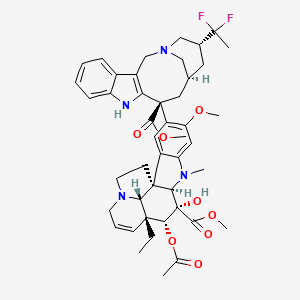



1. Javlor
1. 162652-95-1
2. Javlor
3. 20',20'-difluoro-3',4'-dihydrovinorelbine
4. Chebi:90241
5. 4'-deoxy-20',20'-difluoro-c'-norvincaleukoblastine
6. 5bf646324k
7. Methyl (1r,9r,10s,11r,12r,19r)-11-acetyloxy-4-[(12s,14s,16r)-16-(1,1-difluoroethyl)-12-methoxycarbonyl-1,10-diazatetracyclo[12.3.1.03,11.04,9]octadeca-3(11),4,6,8-tetraen-12-yl]-12-ethyl-10-hydroxy-5-methoxy-8-methyl-8,16-diazapentacyclo[10.6.1.01,9.02,7.016,19]nonadeca-2,4,6,13-tetraene-10-carboxylate
8. 4'-deoxy-20',20'-difluoro-5'-norvincaleukoblastine
9. 4'-deoxy-20',20'-difluoro-8'-norvincaleukoblastine
10. Vinflunine [inn]
11. Vinflunine [inn:ban]
12. Vinflunina
13. Vinfluninum
14. Unii-5bf646324k
15. L-0070
16. Vinflunine [mi]
17. Vinflunine [mart.]
18. Vinflunine [who-dd]
19. Vinflunine [ema Epar]
20. Chembl2110725
21. Dtxsid30936722
22. Hy-b0628
23. Zinc85537078
24. Db11641
25. C'-norvincaleukoblastine, 4'-deoxy-20',20'-difluoro-
26. 4'-deoxy-20',20'-difluoro-8'-norvincaleucoblastine
27. Methyl (2beta,3beta,4beta,5alpha,12beta,19alpha)-4-(acetyloxy)-15-[(12s,14s,16r)-16-(1,1-difluoroethyl)-12-(methoxycarbonyl)-1,10-diazatetracyclo[12.3.1.0(3,11).0(4,9)]octadeca-3(11),4,6,8-tetraen-12-yl]-3-hydroxy-16-methoxy-1-methyl-6,7-didehydroaspidospermidine-3-carboxylate
| Molecular Weight | 816.9 g/mol |
|---|---|
| Molecular Formula | C45H54F2N4O8 |
| XLogP3 | 4.4 |
| Hydrogen Bond Donor Count | 2 |
| Hydrogen Bond Acceptor Count | 13 |
| Rotatable Bond Count | 10 |
| Exact Mass | 816.39097102 g/mol |
| Monoisotopic Mass | 816.39097102 g/mol |
| Topological Polar Surface Area | 134 Ų |
| Heavy Atom Count | 59 |
| Formal Charge | 0 |
| Complexity | 1720 |
| Isotope Atom Count | 0 |
| Defined Atom Stereocenter Count | 9 |
| Undefined Atom Stereocenter Count | 0 |
| Defined Bond Stereocenter Count | 0 |
| Undefined Bond Stereocenter Count | 0 |
| Covalently Bonded Unit Count | 1 |
For use as a monotherapy in adults with advanced or transitional cell carcinoma of the urothelial tract after failure of a prior platinum-containing therapy.
Javlor is indicated in monotherapy for the treatment of adult patients with advanced or metastatic transitional-cell carcinoma of the urothelial tract after failure of a prior platinum-containing regimen.
Efficacy and safety of vinflunine have not been studied in patients with performance status 2.
The antitumour effects of vinflunine are dependent on concentration and exposure duration of the drug. Vinflunine mediates an anti-mitotic action by inhibiting the microtubule assembly at micromolar concentrations and reducing the rate and extent of microtubule growing events. _In vivo_, vinflunine displays a significant antitumor activity against a broad spectrum of human xenografts in mice both in terms of survival prolongation and tumour growth inhibition. Compared with other vinca alkaloids, vinflunine is a less-potent inductor of drug resistance _in vitro_.
L01CA05
L - Antineoplastic and immunomodulating agents
L01 - Antineoplastic agents
L01C - Plant alkaloids and other natural products
L01CA - Vinca alkaloids and analogues
L01CA05 - Vinflunine
Absorption
Vinflunine displays a linear pharmacokinetic profile in the range of administered doses (from 30 mg/m^2 to 400 mg/m^2) in cancer patients.
Route of Elimination
Fecal excretion accounts for 2/3 of the total elimination of vinflunine and its metabolites and the remaining 1/3 of their elimination indicates urinary excretion.
Volume of Distribution
The terminal volume of distribution is large, 2422 676 L (about 35 l/kg), suggesting extensive distribution into tissues. The ratio between plasma and whole blood concentrations of 0.80 0.12.
Clearance
The total blood clearance was 40 L/h according to a population pharmacokinetic analysis in 372 patients. The inter- and intra-individual variability was low, with the coefficient of variation approximately 25% and 8%, respectively.
The metabolites of influnine are mostly cytochrome P450 3A4, but 4-O-deacetylvinflunine (DVFL) may be slowly formed by multiple esterases. DVFL is the main metabolite and is the only metabolite that retains pharmacological activity.
The mean terminal half-life is approximately 40 h. The half life of the main metabolite, DVFL, is approximately 120 hours.
Microtubules are a major component of the cytoskeleton that have a critical role in maintenance of cell shape, mobility, adhesion and intracellular integrity. They also play a role in the formation of the mitotic spindle and chromosomal segregation to the daughter cells at mitosis. Via GTP hydrolysis at the -tubulin subunit and polymerization of tubulin into linear polymers, microtubules, or macromolecular filaments composed of tubulin heterodimers, are formed via a mechanism of nucleation-elongation. At the onset of mitosis, the interphase microtubule network disassembles into the tubulin. The tubulin reassembles into a new population of mitotic spindle microtubules that further undergo rapid successions of lengthening and shortening until they are attached to the newly duplicated sister chromatids at their centromeres. The dynamic behaviour of microtubules are characterized by two mechanical process: dynamic instability indicating repeated switches of growth and shortening at the ends, and microtubule treadmilling that involves the fast-growing (+) end of the microtubule accompanied by a net loss of the opposite slow-growing (-) end. Microtubule treadmilling plays a critical role in mitosis by generating the forces for separation of the chromosomes in the mitotic spindle from centrosome and kinetochores. In both cancer and normal cells, vinflunine binds to tubulin at or near to the vinca binding sites at -tubulin. It is proposed that in similarity to other vinca alkaloids, vinflunine is most likely to bind to -tubulin subunit at the interdimer interface. Via direct binding to tubulin, vinflunine inhibits microtubule polymerization and induces a G2+M arrest, or a mitotic arrest. Vinflunine disrupts the dynamic function of microtubules by suppressing treadmilling and slowing the microtubule growth rate while increasing growth duration. Ultimately, mitotic accumulation at the metaphase/anaphase transition results in cell apoptosis.